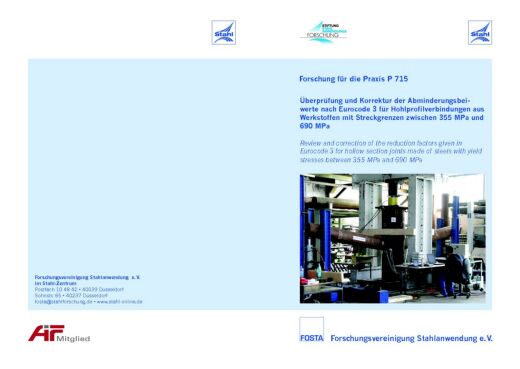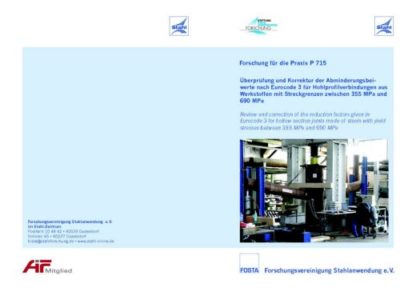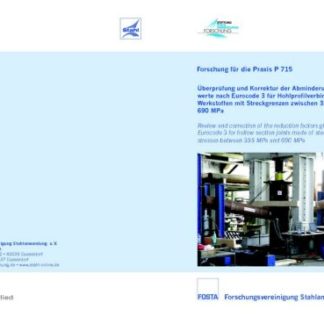Description
P 715 – Review and correction of the reduction factors given in Eurocode 3 for hollow section joints made of steels with yield stresses between 355 MPa and 690 MPa
The design of joints made of hollow sections is to be carried out according DIN EN 1993-1-8. For high strength steels the design is similar to the design of normal steel with yield strengths up to 355 MPa but with taking into account an additional reduction factor for the joint capacity. For steel grades with yield strengths 355 < fy ≤ 460 MPa the design values for the joint capacity have to be reduced by α = 0.9, for yield strengths 460 < fy ≤ 700 MPa a reduction factor of α = 0.8 has to be applied.
In the scope of this research project these reduction factors have been reviewed. Within this, the influence of the geometrical parameters 2γ (chord slenderness), τ (wall thickness ratio) and β (width ratio) on the reduction factors were investigated.
In the experiments X joints made of circular hollow sections (CHS) made of steels S460 and S690 have been investigated. The test specimens were loaded under tension and compression as well as under inplane bending (IPB).
The investigation of the geometrical influences on to the reduction factors was done on basis of FE analysis. Within this, both failure modes Chord Plastification and Punching Shear have been analysed.
The determination of the joint load capacity for Chord Plastification was carried out on basis of the 3% defor-mation criteria. With regard to failure mode Punching Shear an own numerical model was developed which allows to simulate the crack initiation and crack development in the chord. This model needs special input parameters, such as parameters taking into account the multi-axial stresses, which need to be determined on basis of complex experiments. In the scope of this research project these parameters could not be determined.
Thus, for the failure mode Punching Shear no reduction factors have been determined or reviewed.
The experimental results achieved in this project indicate that there might be an option that the checking of the connection can be avoided if the chord slenderness and the thickness ratio fall below certain thresholds. In this case the verification of the joint strength would already be included in the verifications according DIN EN 1993-1-1. Additionally, the existing lower boundary for the chord slenderness (d0/t0 ≥ 10) given in DIN EN 1993-1-8 also could be omitted. Concerning this, additional experimental investigations are necessary.
Because of the low number of test results the significance of the statistical evaluation of these results is low. So, no final recommendations concerning the reduction factors can be given yet.
However, it was confirmed that for all investigated cross sections within the section classes 1 and 2 the reduction factors according DIN EN 1993-1-8 and DIN EN 1993-1-12 are giving safe results.
The research project was carried out at Versuchsanstalt für Stahl, Holz und Steine of the Karlsruher Instituts für Technologie (KIT) and at Labor für Stahl- und Leichtmetallbau der Hochschule München, Fakultät Bauingenieurwesen. FOSTA has accompanied the research work and has organized the project funding from the Foundation for Steel Application Research.
Only available in german language.
Authors:
R. Puthli, S. Herion, O. Fleischer, Ö. Bucak, I. Engelhardt, A. Fischl
Published in:
2014




